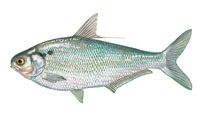Freshwater Fish - Species
Species Specific Regulations
Gizzard shad
Freshwater Fishing License required.
Gizzard shad (Dorosoma cepedianum) - Native
Description: (Anatomy of a Fish)
The gizzard shad has a body that is silvery in color with a bluish-gray back with a large purple-blue spot on the upper side of the body just beyond the operculum or gill flap. The snout, with its downward pointing mouth, is distinctly blunt. There is also a distinguishingly long dorsal fin ray at the back of the dorsal fin.
Range: Statewide, except small streams and foothills streams
Average Length: 10-12 inches
Average Size: 2 pounds
Life Expectancy: Approximately 10 years
Preferred Habitat
Gizzard shad inhabit large rivers, reservoirs, lakes, ponds, pool and sluggish backwaters.
Food Habits
- Microscopic plants and animals by filter feeding with their gill rakers (which function like a strainer catching food).
Spawning
-
Gizzard shad are prolific spawners from March through August. Females release 400,000 sticky eggs that adhere to shallow water substrates until they hatch. The young grow rapidly during their first year, making them available prey for a short period of time.
Miscellaneous
Gizzard shad get their name from their heavy and muscular stomachs that resemble the gizzard of a chicken. The gizzard shad occurs in large numbers in the state’s more productive reservoirs. Here, the shad school in shoreline and open water areas. Gizzard shad are an important prey species for many game fish from hatching through adulthood. However, at full size, they are too large for all but the biggest striped bass, largemouth bass and catfish to consume. Massive die-offs occur in extreme cold weather. They are commonly used as a baitfish.
Commonly Mistaken Species
One species of fish that is commonly mistaken for this species is:
Literature Cited
Rohde, Fred C, Arndt, Rudolf G., Foltz, Jeffery W., Quattro, Joseph M. 2009. Freshwater Fishes of South Carolina. University of South Carolina Press, Columbia, South Carolina.
Wildlife and Freshwater Fisheries Division. 2009. South Carolina Guide to Freshwater Fishes.
Fish Illustration by Duane Raver.


